So you finally decided to get serious about your career as a vlogger or filmmaker, right?
You’ll have a lot of fun along the way since the video-making industry is exciting, profitable and continuously expanding.
In fact, studies show that businesses which use video content grow up to 49% faster than those which don’t.
But what video equipment do you buy first?
Most likely you’re not ready yet to spend thousands of dollars on A+, expert equipment used by the pros, right?
In this case, we got you covered!
We created a small list of “essentials”. These video products are ideal for you at the beginning of your career. They will help you learn your craft quickly and have a lot of fun in the process.
Keep reading to find out a list of useful video accessories too. Let’s start with the most important tool of the trade – the camera.
#1 – Video Camera
You cannot produce a video without a video camera and there are numerous options for you.
There are 3 types of camera you should focus on:
- Camcorders
- DSLR and mirrorless cameras
- Compact cameras
Camcorders
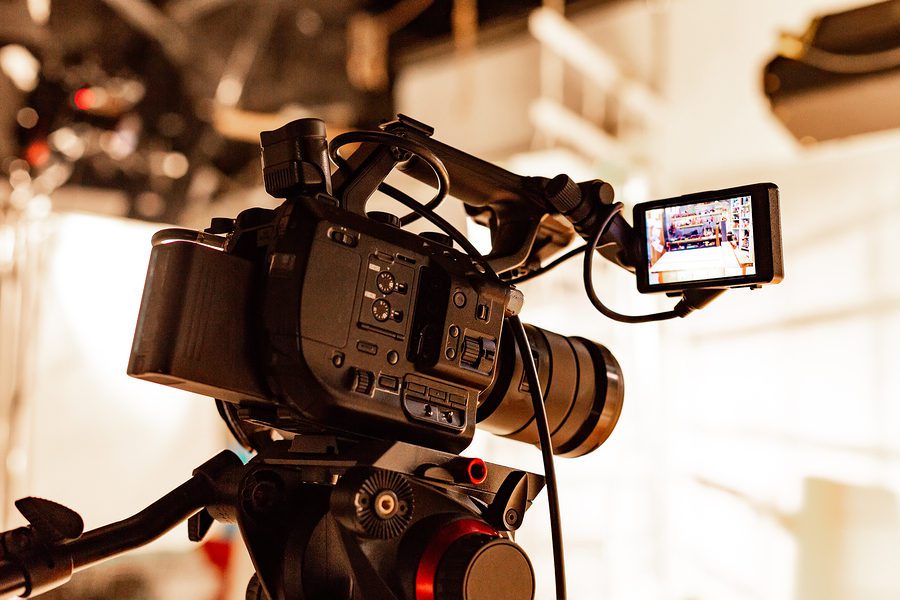
A camcorder is a portable video camera and video recorder in one package. Most types come with a zoom lens and autofocus.
Camcorders are usually equipped with a on-camera microphone with wind protector and sometimes a on-camera light as well.
Camcorders can film in numerous video formats including FullHD and some even 4K. They also have various settings for slow-motion capture and other effects.
Sometimes you can find good deals on a package that includes everything you need to get started, e.g. memory cards, a tripod, and a protective case.
Camcorders pricing
Camcorders come at different prices, depending on their features and capabilities.
Check out the best professional camcorders for any budget on the market today.
For example, budget consumer camcorders can come at prices around $1,000-$1,200. Some of them might also include accessories such as lenses or tripods.
Mid-range prosumer cameras might set you back about $5,000 on average. They are ideal for professional videos, and the filmmaker who wants to grow.
Moving on to the high-end range, you can find very advanced cameras such as the RED Scarlet, Blackmagic Ursa Mini, Sony FX6 or FX9, Arri Amira, Panasonic EVA7, Canon C500 – to name a few.
These high-end professional cameras are not really considered camcorders – but are moving in to cinema camera territory. They don’t come with anything except the body.
So you need to pay extra for lenses (which can easily be just as expensive as the camera), batteries, racks, lights, microphones, and memory cards.
A used one can easily cost you up to $10,000 for the body only.
There are other high-end cinema cameras which are even more expensive than that.
But when you’re just starting out, you definitely don’t need all these features. Luckily, you can go for a camcorder which come with everything you need in the package.
DSLR and mirrorless cameras

If you want a camera which is also useful for taking photos, you should go with a DSLR or mirrorless camera.
These are very popular and frequently used in videography. Whether you’re an avid YouTuber, vlogger or an aspiring filmmaker, a DSLR or mirrorless camera is the ideal tool for the job.
A decent DSLR or mirrorless camera can cost around $500-$700, depending on various factors. Go for reputable brands such as Nikon, Canon, Fujifilm, Panasonic or Sony.
Almost all DSLR or mirrorless cameras are capable of recording video footage in FHD (1920 x 1080p). Some of them can even record in 4K and more.
Especially if you mount a mic and/or light on top of your DSLR or mirrorless camera, make sure that the tripod is durable and can take the extra weight.
You might also need an external microphone to pick up sound from your subject or from your surroundings.
In fact, this is one point where a camcorder differs from DSLRs and mirrorless.
Keep in mind the cost of extra accessories needed for hybrid video and photography cameras
Because DSLRs and mirrorless cameras initially were only designed for photography, they don’t come with a good on-camera microphone or light. So these are extra things you need to buy.
However, they’re more versatile in that they also take photos and also smaller than camcorders. This is good if you won’t want to draw attention to yourself, for example if you are filming an event or a wedding.
If you go the DSRL/mirrorless route and get an external mic, a LED light, and a tripod, you will probably also need a larger carrying bag – such as a backpack – to keep all these accessories.
There are bags and backpacks specially designed for photography and videography gear. Keep reading as we’ll talk about carrying bags later on in the article.
If you’re still unsure whether to pick a camcorder or hybrid camera, I recommend you read Which Camera Is Best? Camcorders vs DSLRs vs Mirrorless.
Compact Point-and-Shoot Cameras
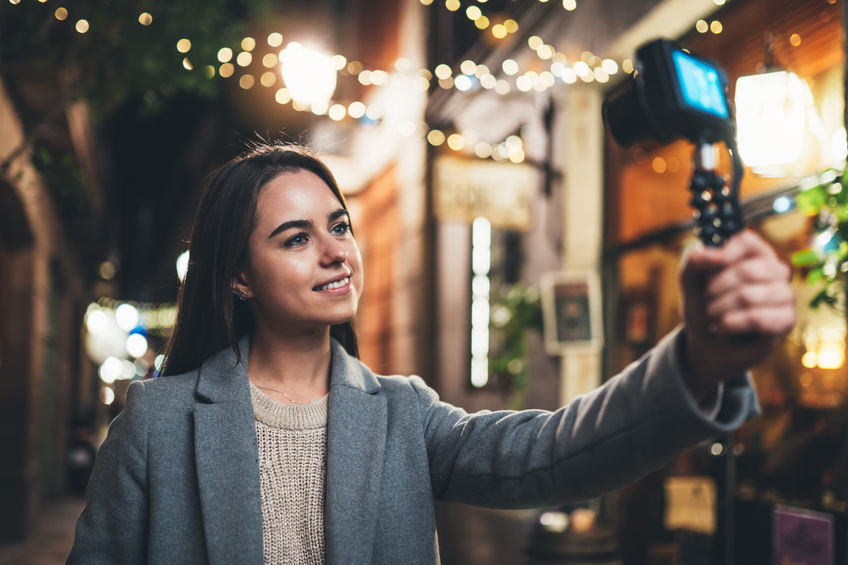
Compact digital cameras are also known as point-and-shoot cameras.
They are much smaller in comparison with DSLR cameras. Some of them can even fit your pocket.
“But why do I need a compact camera if I could have a DSLR or mirrorless?” you might ask. This is a good question!
You don’t necessarily need this type of camera, but it’s a good option for beginner filmmakers, because they’re a lot cheaper to buy. For example, you don’t need to buy separate lenses.
When you do decide to upgrade, you can use your point-and-shoot camera as a second camera for B-roll footage.
Compact cameras are on a decline though, because almost no one buys them anymore. Mobile phones have eaten into this market. However, this makes it possible for you to pick up a point-and-shoot camera dirt cheap which shoots 4K.
And compact cameras still have dedicated software, which makes them faster than mobile phones to use.
They also have optical zoom lenses, which offer much better quality than the electronic zoom any mobile phone provide.
Speaking of which…
Mobile phones
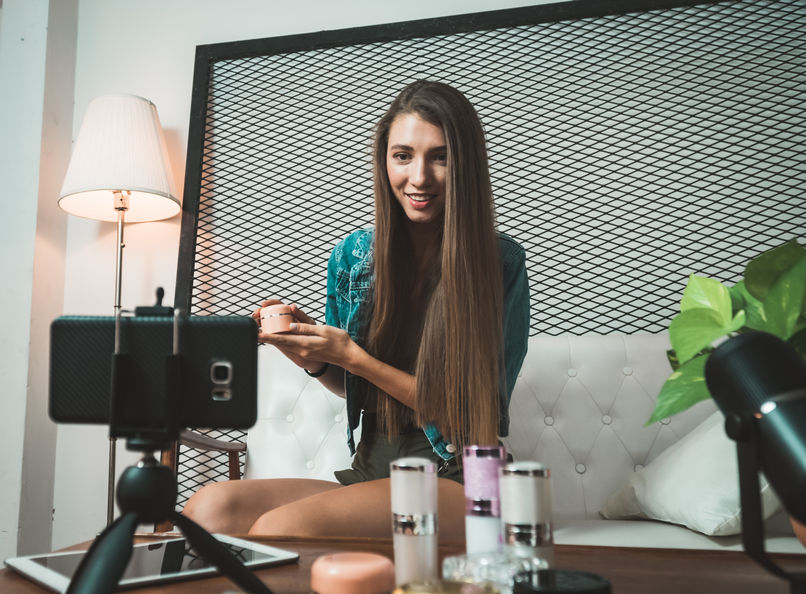
It is actually possible to shoot an entire feature film on a mobile phone if you know how to use lighting and accessories to your advantage.
Several filmmakers have done this already like Steven Soderbergh’s’ drama “Unsane” and Sean Baker’s “Tangerine”.
If your mobile device is capable of shooting high-quality video, you can have a lot of fun experimenting with that for a while.
This will give you a head start when it comes to shooting videos and help you learn the basics. Moreover, you can buy certain camera accessories for your phone to improve the picture/video quality.
For example, you can go for a fisheye lens that attaches to your smartphone’s camera. It allows you to capture amazing fisheye videos and pictures.
Some people prefer macro-photography (you know, filming or taking of plants and insects up close).
You can do that with your phone using a macro lens attachment. You can even go for a wide-angle lens, which expands your field of view.
Have a look at our article What Is The Best Lens Attachment For Smartphones? if you want to know more about these.
All of these devices come at reasonable prices and provide the perfect opportunity to experiment until you’re ready for more advanced videography gear.
#2 – Tripod
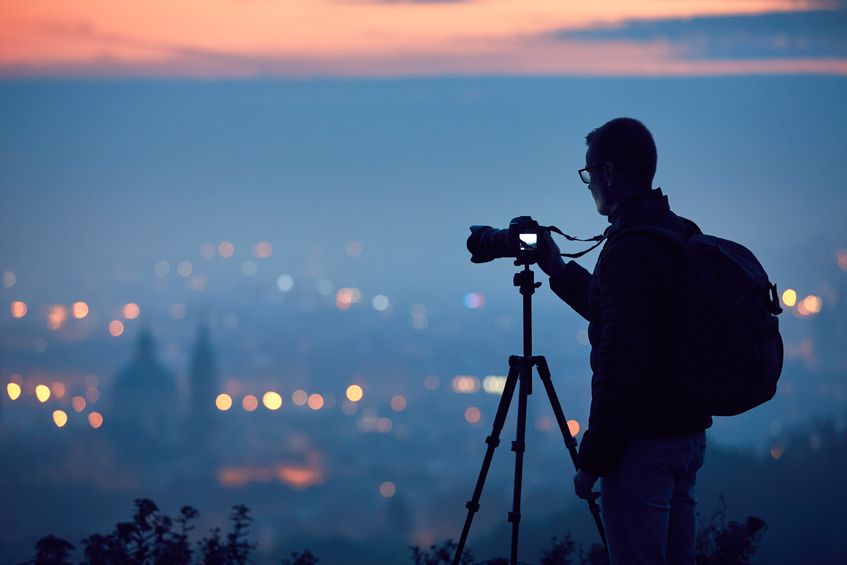
A tripod is an essential piece of equipment you need, whether you’re a beginner or a professional filmmaker.
Just as the name implies, tripods are lightweight stands with three legs. They are usually made from metals such as aluminum or carbon fiber, and can be adjusted by height.
Tripods ensure that your video footage is smooth and stable. You place your video camera on a tripod and record videos of your subjects or surrounding areas.
This also means that you don’t have to hold the cameras in your hands. This can be a tiresome experience, especially if you shoot for a few hours straight.
You can make real-time adjustments to your camera while it’s on the tripod such as zooming in and out while still capturing stable footage.
Tripods can be set up in minutes and they’re easy to carry too. You don’t have to go for a high-end one at first, basic tripods can do the job just fine.
If you want to learn more about the different types of tripods for video, I recommend reading this guide.
#3 – Lenses
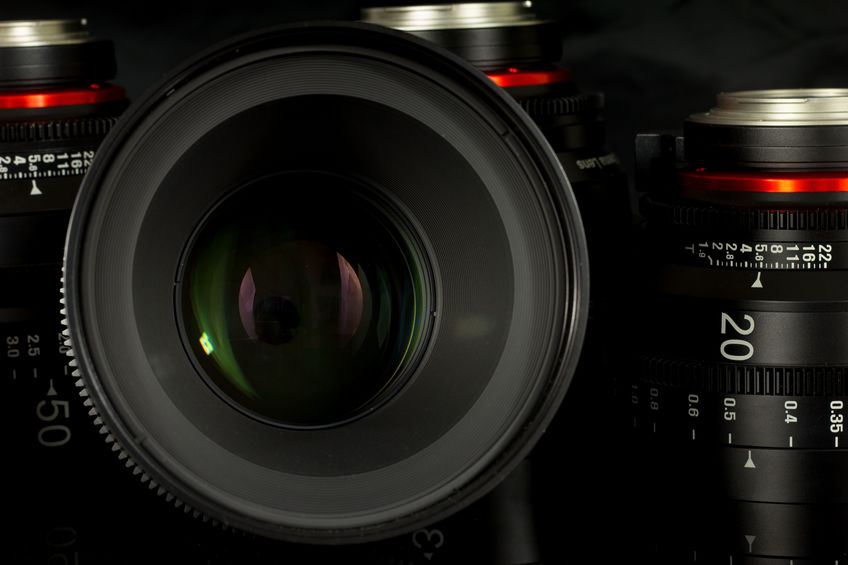
Besides the camera, lenses are the most important gear when shooting videos or photos.
You can use lenses designed for photography or dedicated cinema lenses, which focus gears, like the ones in the photo above.
Both types have their pros and cons. You can read more about cinema lenses in our guide Best Affordable Cine Lenses (Budget, Mid-Range, and Professional).
Primes vs. zooms
Generally speaking, you can divide lenses into two types: primes and zooms.
Prime lenses have a fixed focal length, e.g., 50 mm. This means that if you want to get closer to a subject, you have to move your feet. You “zoom” with your feet, so to speak.
Zoom lenses have a variable focal distance, e.g., 24-70 mm or 14-140 mm. This makes it possible to stay where you are and zoom in on your subject. This is very handy if you want to film an angry crocodile.
Wide Angle Lenses
A wide-angle lens has a small focal length in comparison with other types of lenses.
This allows you to take in more “scene” while shooting videos or photos. Wide-angle lenses are ideal if you want to emphasize the size of a particular landscape or the vast distances between objects.
Fish-eye lenses have focal distances from 8mm to 35mm and they are frequently used to capture a huge amount of detail. You can use fish-eye lenses for shooting videos of landscapes, cityspaces as well as humans or animals.
Wide angle lenses can be both primes and zooms.
Normal Range Lenses
A mid-range lens has a focal distance between 35mm to 85mm.
Just like the name implies, they are something “in between”. These lenses can be used for interviews, portraits, shooting video on the streets, etc.
By the way, a lens with a focal distance of 50mm is good for many shooting purposes.
For this reason, it is also called a “nifty-fifty” and can be used for shooting videos of close as well as far subjects. If you ask a bunch of photographers to only pick one lens the 50mm will be the one a lot of them will choose.
Normal range lenses can be both primes and zooms.
Telezoom Lenses
Lenses which have a focal distance above 85mm are called “telezooms”. They are ideal for shooting videos of animals, plants, birds, etc.
Telezooms can be anywhere from 85mm to 135mm (short), 135mm to 300 (medium), and 300mm to +1000mm (super).
They are also frequently used for sports events. They take pictures of subjects situated at a far distance.
If you plan to shoot videos of birds or sports, you should get a telezoom lens and experiment with it.
Telezoom lenses can be both primes and zooms.
Niche Lenses
A few good example of niche lenses are the macro lens and tilt-shift lens.
Macro lenses are used to take pictures or shoot videos of objects very close to the camera. When you see a photo outlining a flower’s petal’s beautiful details, it has been shot using a macro lens.
Macro lenses can focus from infinity up to 1:1 magnification. This means that the image captured by the sensor has the same size as the object in real life.
Some macro lenses have other magnification ratios such as 1:2, 1:5, etc. You need to play with a few of these lenses to see exactly what you prefer.
A tilt-shift lens can make you video of houses, cars, landscapes etc. look like they’re in a miniature landscape.

It has optics designed to tilt or shift, depending on the preferences of the photographer.
In other words, you can simply tilt the lens upwards or downwards while the image sensor remains stable. This allows you to capture different types of beautiful images and videos a regular lens cannot capture.
Tilt-shift lenses might be a little bit more complicated, but they offer immense creativity freedom. You can use them to create panoramic images or to capture subjects at unique angles.
You can create a similar effect in software, but nothing beats the real deal.
#4 – Video Software
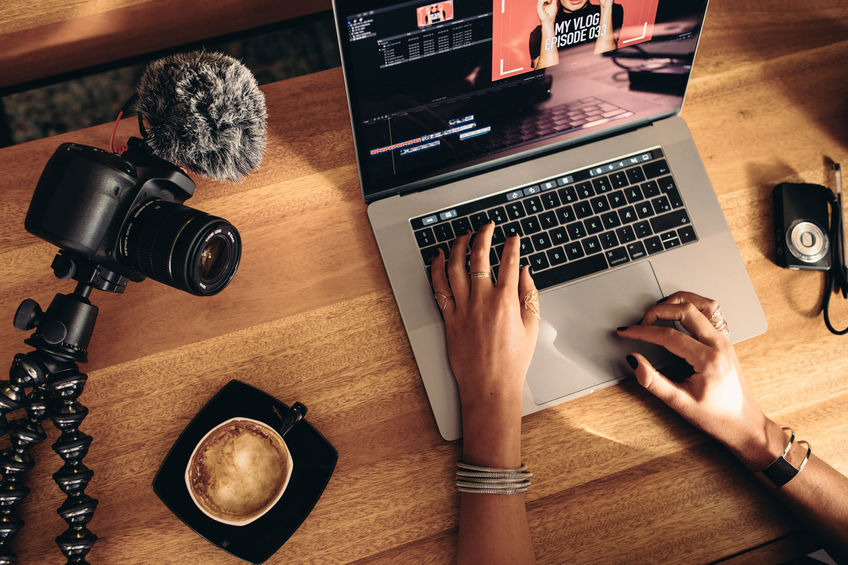
You need a good video software to edit your videos.
Most video editing software today will let you edit your video footage, add text, edit audio tracks, add visual effects, do color grading and change the resolution of the final clip.
If you want to work with large resolutions such as Full HD or 4K, you might need a powerful machine to be able to render these videos quickly.
Just make sure your machine has at least 8GB of RAM, 2GB of video and preferably an SSD to make things smoother.
You have endless freedom when it comes to what you can accomplish with video software.
Some of them are ideal for beginners, others are designed for pros.
There are multiple video editing programs out there – some are good, and some are not.
Below, I’ve divided the video editing software into three categories – free, budget-friendly, and professional. I’ve gone to great lengths only to pick top-quality programs.
Free Video Editing Software
These programs can be used for free. Some of them have a paid version and you can upgrade when you’re ready to learn more.
Hitfilm Express is a powerful piece of software which lets you create professional videos. It comes with a lot of effects and presets, color grading tools, and you can work in both 2D and 3D space. It’s basically like having Premiere Pro and After Effects in one package.
DaVinci Resolve is another free and very powerful program designed for both beginners and pros. It offers excellent color correction tools as it started out as a color correction suite. But the later iterations have included powerful editing tools as well, so now you can make everything in one program.
iMovie is the standard editing program which comes with every Mac. It is fully capable of producing professional videos. And when you’ve outgrown its features, it is easy to upgrade and start working in Final Cut.
You can find more free video editing software in Best Free Video Editing Software (Mac, PC, Linux, Online).
Budget-friendly video editing software
These programs require a small investment from your behalf, but they will take your video editing skills to the next level.
Adobe Premiere Elements is ideal for Macs and PCs, this program comes with numerous features and add-ons to help you create breathtaking videos.
Filmora is an easy-to-use editor which are capable of producing professional videos. It has a lot of professional features such as the ability to work with proxies (if you don’t have a powerful computer for 4K footage), in-built effects, and color grading tools.
Sony Vegas Movie Studio is a scaled-down version of Sony Vegas Pro. It has a lot of features for making professional videos, but you can only edit ten video tracks and ten audio tracks at a time (unless you go for the Platinum package, which doubles these numbers). But that should also be more than enough to get you started.
Professional video editing software
These programs are designed mostly for professional users who want to create stunning video clips.
Adobe Premiere Pro is one of the best video editing software out there. It gives you immense freedom to edit, crop, cut and add visual effects to your videos. And you get full integration with the rest of the Adobe Suite.
Apple Final Cut Pro X is specially designed for Apple users, this program features unlimited video tracks and multi-camera editing.
Sony Vegas Pro is a professional editing program for Windows which is utilized by major broadcasters and filmmakers. It has a lot of features and can produce fully professional motion pictures.
Read more about Premiere and Final Cut in Apple Final Cut Pro vs. Adobe Premiere Pro: Which is Better and Why?
#5 – Lighting
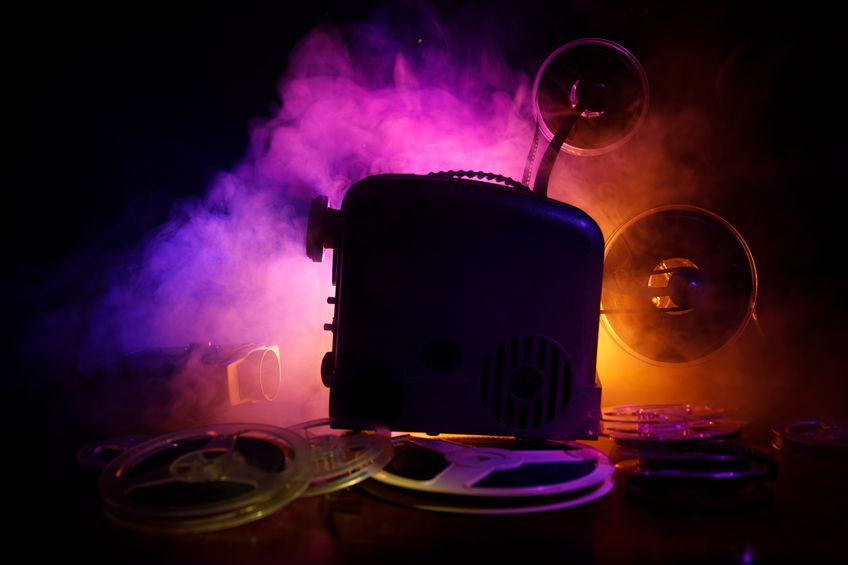
Proper lighting makes the difference between amateur video footage and professional video footage.
There are numerous lighting accessories you can choose from, but as a beginner, it’s important to start with the basics.
If you went with a DSLR camera, you can go for a simple dimmable LED light which can be attached on top of your device.
Such LED lights are compatible with multiple cameras, can be powered by batteries and they can be attached and detached easily.
If you’re serious about videography, you should get a 3-point lighting kit. Three-point lighting is frequently used in videography and photography. It consists of the key light, fill light and backlight.
Your 3-point lighting kit can also include various light bulbs, tripods, light stands, softboxes, reflectors, a carrying bag, and other accessories.
These will help you shoot high-quality video of a subject both indoors and outdoors.
Best of all, these basic lighting kits aren’t expensive and they can be packed and carried in the supplied carrying bag wherever you go.
When you become more experienced, you’ll eventually have to invest in more advanced lighting options.
If you want to learn more about different lights and lighting setups for video, I recommend you read this 3-part guide.
#6 – External Microphone

An external microphone helps to pick up sound from your subject or the surrounding areas.
It is a vital accessory, even if you go for a high-end camera which already comes with a microphone.
External mics are specially designed to be more sensitive and register a broad spectrum of sounds.
If you plan to shoot video lessons, interviews, outdoor adventures with your friends, or pretty much anything else with sound, you need an external microphone.
Most professionals use shot-gun microphones mounted on a boom pole. But this setup requires extra stands and/or a dedicated sound person.
You can read more about shotgun microphones and boom poles in A Guide To Shotgun Microphones And Boom Poles For Filmmaking.
For the one-man videographer a on-camera microphone or wireless lavalier microphone is often the best chance. Luckily, you can get high-quality ones without breaking the bank.
On-camera Microphones

Just like LED lights that clip to your DSLR camera, you can also go for microphones, which can be attached on top of your DSLR device.
These are relatively compact mics and connect to your camera using a small wire.
They record high-quality sound and are ideal if you want to film events, interviews, people talking, etc.
These microphones are made from durable materials and are protected against shocks and vibration. They also minimize the surrounding noise, capturing sound directly from the subject in front of it.
Microphones can also be attached to your DSLR camera. They occupy the hotshoe slot on top of your device.
The hotshoe is a mounting point on top of your DSLR camera. It is specially designed to let you connect a light or microphone.
But what if you want to connect both at the same time?
In this case, you might need to invest in an inexpensive dual mount cold shoe. This mounting unit holds both the mic and your LED light in a stable position on top of your device.
See some great choices for on-camera microphones in Top 8 Best Budget-Friendly On-Camera Shotgun Microphones.
Wireless Microphones

These mics are more suitable for people who want portability.
Wireless mics pick up sound from a certain area and send it wirelessly to a nearby station where it is decoded and recorded.
The lavalier microphone used by TV presenters is a good example in this case.
Wireless microphones are great when it comes to picking up high-quality sound while reducing background noise.
They are also affordable and ideal for novice filmmakers interested in shooting a lot of interviews or speeches.
You can see a test I did of some wireless lavalier microphones in Rode Wireless GO vs FotoWelt AirPlus vs Sennheiser XS vs FotoWelt MK-7 Lavalier Test Review.
#7 – Accessories
There are numerous accessories a videographer will need, especially in the beginning.
These products are designed to make your life easier and improve your film-making experience.
You might not need all of these products right from the start, but it’s a good idea to know about them.
Here are a few good examples of accessories:
- Memory cards
- Portable Hard drives
- Batteries
- Gimbal
- Carrying bag
- Light reflectors
Let’s talk about each of them.
Memory Cards
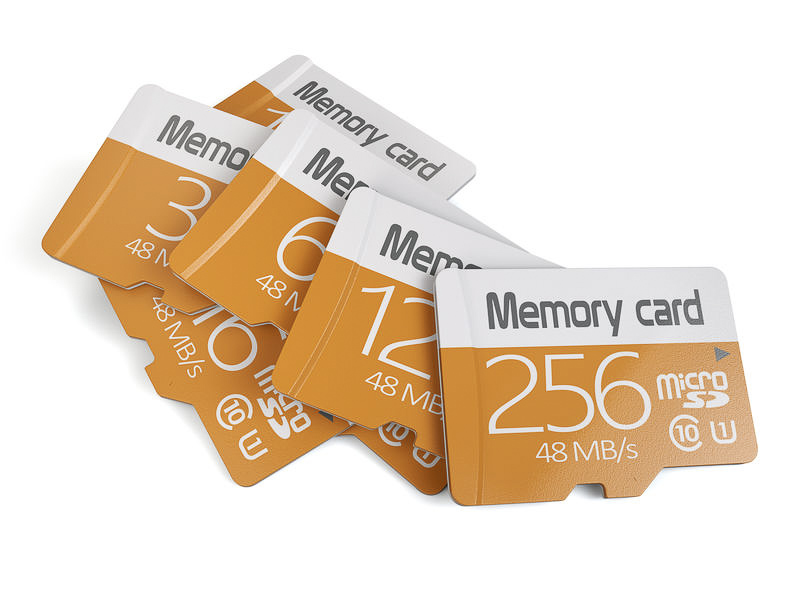
Memory cards are inserted in your video cameras to store video footage.
These items come in various storage sizes such as 16GB, 32GB, 64GB and more.
It’s vital to go for high-speed memory cards to ensure quick data transfers.
For example, a high-speed memory card can make the difference between transferring a file in 10 minutes or 2 hours from your camera to your laptop.
Secondly, it is a good idea to not go for memory cards with sizes larger than 32GB or 64GB. You need to regularly transfer clips from memory cards to your computer to ensure their safety.
If you go with a 512GB memory card, for example, you put 512GB worth of data on a single memory card. If it goes corrupt or you lose it, you’re going to end up really frustrated.
Instead, use multiple 64GB cards and copy video footage regularly.
Read more about SD memory cards in What Is the Best SD Card for 4K Video?
Portable Hard Drives

This is another great accessory suitable for people who shoot a lot of videos outdoors.
A spacious hard drive lets you store data from your memory cards. Once your memory cards are free again, you can shoot more video footage. When you finally finished your shooting day, you can copy data from your portable hard drive to your computer.
As a result, you don’t have to carry your laptop with you outdoors to copy video clips.
Portable hard drives also need to ensure fast connectivity. Don’t skimp here and go for good ones which have USB Type C or Thunderbolt 3.0.
If you plan to shoot video clips mostly outdoors, you might want to go for a portable hard drive which is resistant to dust, vibrations, water and other damaging agents.
When it comes to storage size, portable hard drives can store from 250GB up to 5,000GB or even more, depending on your preferences and needs.
If you want to know more about memory cards have a look at the Ultimate Guide To Memory Cards And SSDs For Video Recording.
Batteries

What would we do without batteries?
They power our world, allowing us to do what we like anywhere, without being dependent on a power socket.
Your video cameras require batteries. Bigger manufacturers such as Sony, Canon, and Panasonic make their own batteries, and your camera usually comes with a single battery included.
It’s a good idea to buy extras though!
You can often buy 3rd-party batteries as well, but be careful not to buy too cheap, since these often don’t last as long – and can even be dangerous. The same goes for battery chargers.
I always stick with batteries from well-known manufacturers.
Some LED light kits and external microphones also work with AA or AAA batteries.
When you move up to bigger cameras and lights, you’ll stumble upon V-lock batteries and Anton Bauer Gold Mount batteries, which can be used across different cameras and lights.
You can read my guide to Gold Mount and V-mount batteries here.
Make sure you have enough of them in your bag. The worst thing that can happen to you is to not be able to capture a stunning video clip because your batteries are dead.
Oh, and here’s a tip. Go for a dual charger to charge two batteries at once.
Gimbal

Gimbals are ideal for vloggers who shoot a lot of videos while talking and walking.
Even if your video camera comes with state-of-the-art image stabilization, the video recorded will still be quite shaky.
Gimbals are small, handheld supports which neutralize any hand shaking or movement. They help shooting video footage which is smooth-as-silk.
Think of a gimbal as a self-adjusting selfie stick. Its sensors continuously adjust your video camera to make the footage stable.
Carrying Bag
Especially if you plan to travel a lot, shooting videos everywhere you go, you need a good-quality carrying bag.
There are numerous ones out there and some of them are specially designed for videographers and photographers.
For example, there are bags designed to hold a DSLR camera, multiple lenses, a portable hard drive and other accessories. These bags include compartments to keep your expensive gear stable while traveling.
You can also go for a bag for your tripod and/or lighting kit. This will be a larger bag with special compartments for light stands, light sources, softboxes, etc.
A high-quality bag doesn’t only keep your precious gear in one place, but it might also protect it against dust and rain. Make sure that you pick a good one to avoid damages to your video equipment.
Light Reflectors
Another excellent category of accessories is represented by light modifiers, particularly reflectors.
They come in various sizes and shapes and they have one job – to reflect the light coming from various sources and direct it towards your subject.
Light reflectors can substitute fill lights. They can bounce back a part of the light coming from your main light source and bathe your subject in a glowing soft light.
Some light reflectors are mounted directly on light sources to widen or narrow the light beam.
Others have a certain tint such as gold, blue or red, changing the temperature of the light reflected back to the subject.
Conclusion
In this article, we tried to include the most basic items required to start your career as a filmmaker.
There are other accessories you might need, but these are essential for beginners.
The next step would be to set up a budget and start prioritizing some of these items.
For example, spend more on a good-quality camera, a microphone and a lighting kit. The rest of your money should be directed towards light modifiers, larger hard drives, more advanced video editing software, etc.
These are just the basics, but they’ll make it possible for you to make professional videos.
As you get started and start to home in on your niche, you’ll quickly understand where you need to upgrade and what extra pieces of gear you need for the type of production you want to make.
Video making is a fun but sometimes expensive rabbit hole to dive into. But it is totally worth it!
Got any questions or comments? Please share in the comment section below.


ShotCut is another free video software program that makes it easier to learn how to use video editing software without having to pay the high price tag. I used it for my own personal video editing and it did a great job for a free program. Once I needed more professional software I switched to PremierePro and it was an easy transition coming from ShotCut since both are easy enough to open and use without a lot of knowledge beforehand.
Hi Nick.
Yes, ShotCut is a great option. It’s included in this article: https://filmdaft.com/best-free-video-editing-software-mac-pc-linux-online/
Best, Jan